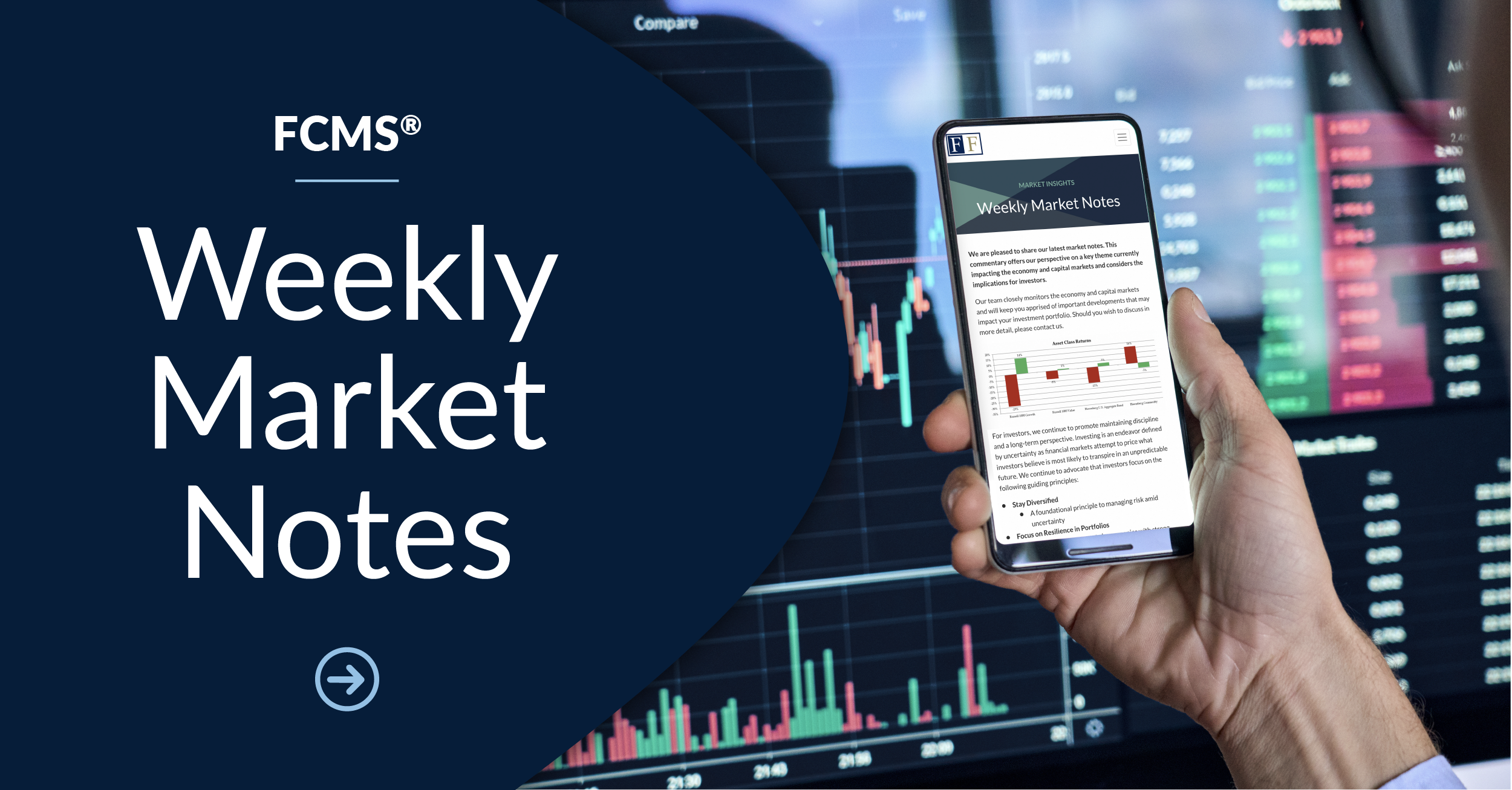Market Review & Outlook
Strong gains by a select group of stock market darlings, led by Nvidia, pulled the S&P 500 index higher in Q2 but masked weakness in the broader universe of U.S. and international stocks.
The S&P 500 rose 4.3% in the second quarter and extended its gains to over 15% through the first half of the year. The past year and a half has been an exceptional period for the widely followed U.S. headline index, which has been led higher by a select group of large U.S. technology stocks, popularly referred to as the “Magnificent 7”.
However, despite another quarter of gains in the S&P 500 index, the broader universe of stocks, both domestic and international, suffered a challenging quarter with most posting declines. Notably, an equal-weighted version of the S&P 500, in which each stock comprises an equal weight in the index, declined -2.6% last quarter. The Russell 2000, an index of small capitalization U.S. stocks, and the MSCI EAFE, an index of international stocks, also both declined last quarter by -3.3% and -0.6%, respectively.
Bond markets posted another lackluster quarter with the Bloomberg U.S. Aggregate Bond index posting a return of close to 0% and leaving investors with a loss of -0.7% through the first half of 2024.
Despite the higher yields available in fixed income markets, bond price declines have offset the returns from interest income so far this year. Bond prices have declined because interest rates have risen amid stubborn inflation and higher-for-longer interest rate policy from the Federal Reserve.
Bonds remain mired in one of their worst bear markets in decades due to the sharp rise in interest rates in recent years with the Bloomberg U.S. Aggregate Bond index producing a cumulative return of -8.7% over the past three years.
Is the U.S. stock market inflating into another bubble akin to the late 1990s?
As major U.S. stock market indices, notably the S&P 500 and NASDAQ Composite, continue to generate outsized gains and ascend new highs, some investors have begun to ask whether these markets are entering a bubble phase akin to the technology bubble of the late 1990s. While we see several parallels between the two periods, there are a few key differences that lead us to conclude that the circumstances of U.S. stock markets today are different and likely better characterized by the old adage widely attributed to Mark Twain that “history doesn’t repeat itself, but it often rhymes.”
Below is a summary of key similarities and differences between U.S. stock markets today and the late 1990s:
Key Similarities
- Markets indices are being led higher by incredible gains in a select group of stocks tied to the emergence of transformative new technology.
- Commercialization of the internet in the 1990s; commercialization of artificial intelligence (AI) today
- Ascendance of a new market leader expected to dominate because of an early and dominant leadership position tied to this new wave of transformative technology.
- Cisco in the 1990s; Nvidia today
- Significant underperformance of stocks not expected to benefit from the transformative wave of new technology (i.e., small cap, value, and international stocks).
- An explosion of retail trading activity as individual investors seek profits from the massive, and often rapid, gains in stocks tied to the transformative new technology
- Day traders in the 1990s; meme stocks, zero-day options, and 24/7 trading access today
Key Differences
The profitability of the stock market darlings of today is generally much stronger than those of the late 1990s.
- The market leaders of today (Apple, Amazon, Alphabet/Google, Meta/Facebook, Microsoft, Nvidia) are largely well-established technology companies generating significant profits that also have an abundance of cash on their balance sheets to fund investment in their businesses for future growth.
- In contrast, the stock market darlings of the late 1990s included many unprofitable businesses that were reliant on external sources of capital to fund investment in their businesses for growth in the hope of producing future profits.
In short, the technology companies that are leading markets higher today are much stronger and more resilient businesses than those of 25 years ago.
Investment Outlook
Amid rising optimism among stock market investors, we continue to be cognizant of potential risks. We are watching the following factors to help us discern if the U.S. economy will continue proving resilient or the growing consensus of a soft economic landing is premature.
Will the U.S. economy continue to defy higher interest rates?
Amid widespread predictions of recession in recent years, the U.S. economy has continued to grow and consistently surpass expectations. U.S. consumers have continued to spend amid a healthy job market, excess pandemic savings, and rising home and asset prices. U.S. households and businesses were also opportunistic in locking in low interest rates for longer periods of time in 2020 and 2021, which has significantly dampened the effect of higher interest rates on economic activity so far.
Will inflation reaccelerate and result in renewed pressure on stock and bond markets?
Inflation has decelerated meaningfully since 2022 but progress has stalled of late with the rate of inflation proving frustratingly sticky above the Federal Reserve’s 2% target. As a result, market expectations for interest rate cuts have continually been pushed back since the beginning of the year, which has resulted in higher rates and continued struggles for bond markets.
Will geopolitical risk disrupt recent market calm?
We typically do not focus on geopolitical events as the results and implications have historically proven unpredictable and the impacts typically have an outsized market impact in the short term but a more limited effect over the long term. However, with several notable elections upcoming in the second half of the year, including in the U.S., and subdued volatility levels in markets indicating rising complacency among investors, we will be monitoring these events more closely than normal over the coming months.
Perspectives for Investors
We believe attempting to discern whether the stock market is in a bubble, and if it is, when the bubble is likely to burst, is a fool’s errand in attempting to time markets. There is a lot of good news priced into U.S. stock markets at current valuations, which has raised the bar for companies, especially the leading technology stocks that have drove markets higher, and reduced the margin of safety for investors should their results not achieve these rosy expectations. However, these companies have consistently delivered results in recent years amid rising expectations, and they are much healthier and more resilient companies than their counterparts from the 1990s.
For investors, we continue to advocate staying disciplined and focused on your long-term plan. We also believe diversification remains of paramount importance in helping investors to continue benefitting from the opportunities in these new technology trends while also managing risk should the reality not fully live up to the hype at current valuation levels.
Discover more from the FCMS Investment Committee by subscribing to our Founders Insights blog and following us on LinkedIn.
Authored by the Freedom Capital Management Strategies® Investment Team | July 2024
Securities and Investment Advisory Services offered through Founders Financial Securities, LLC. Member FINRA, SIPC and Registered Investment Advisor.
This material contains the opinions of the author(s) but not necessarily those of Founders Financial Securities, LLC and such opinions are subject to change without notice. This material has been distributed for informational purposes only. Forecasts, estimates, and certain information contained herein are based upon proprietary research and should not be considered as investment advice or a recommendation of any particular security, strategy, or investment product. Information contained herein has been obtained from sources believed to be reliable but is not guaranteed. Past performance does not guarantee future results.






